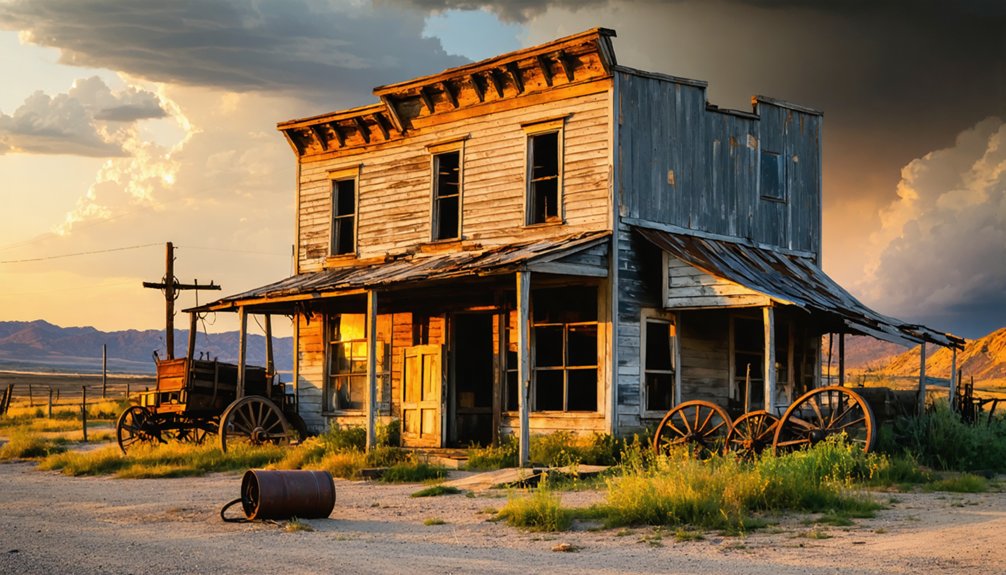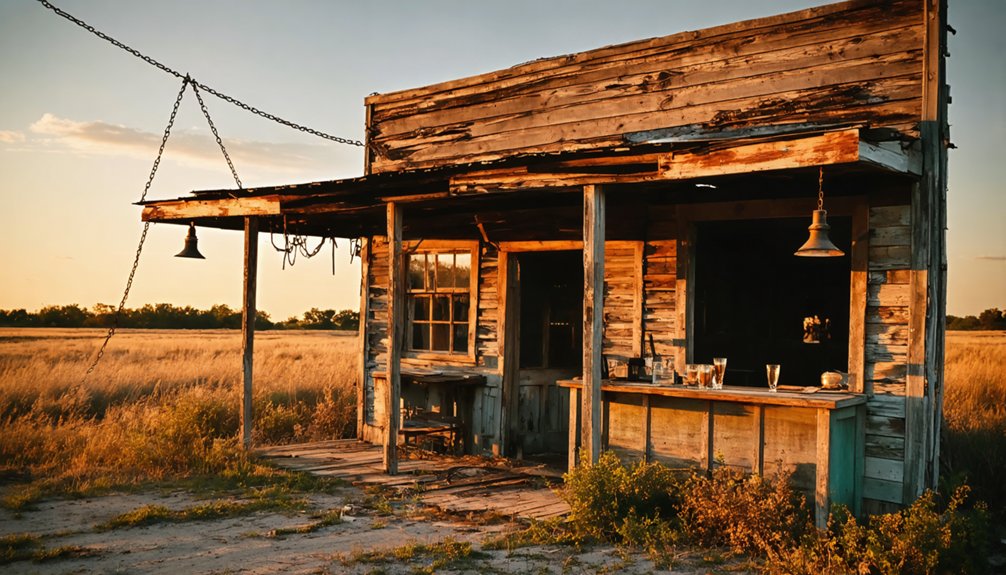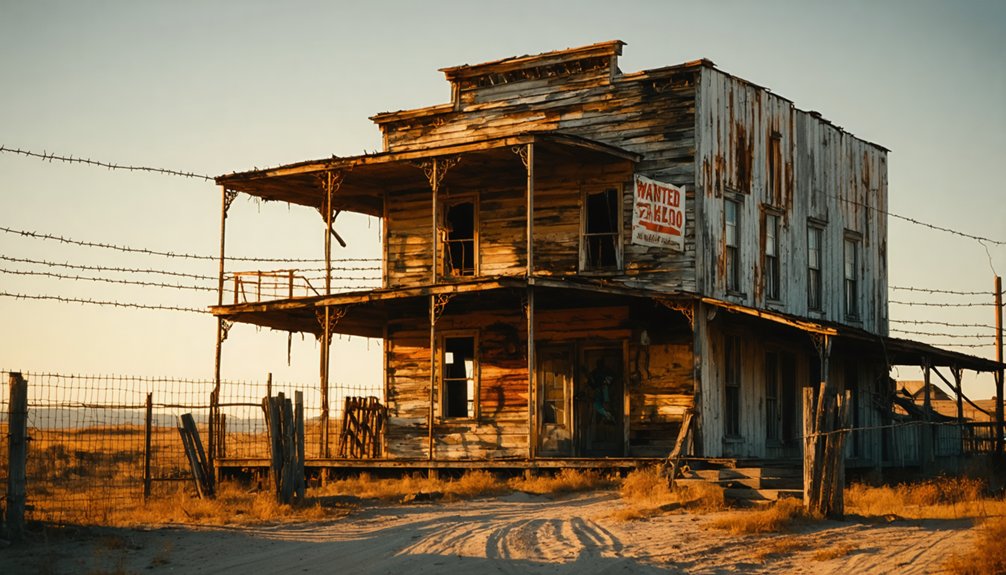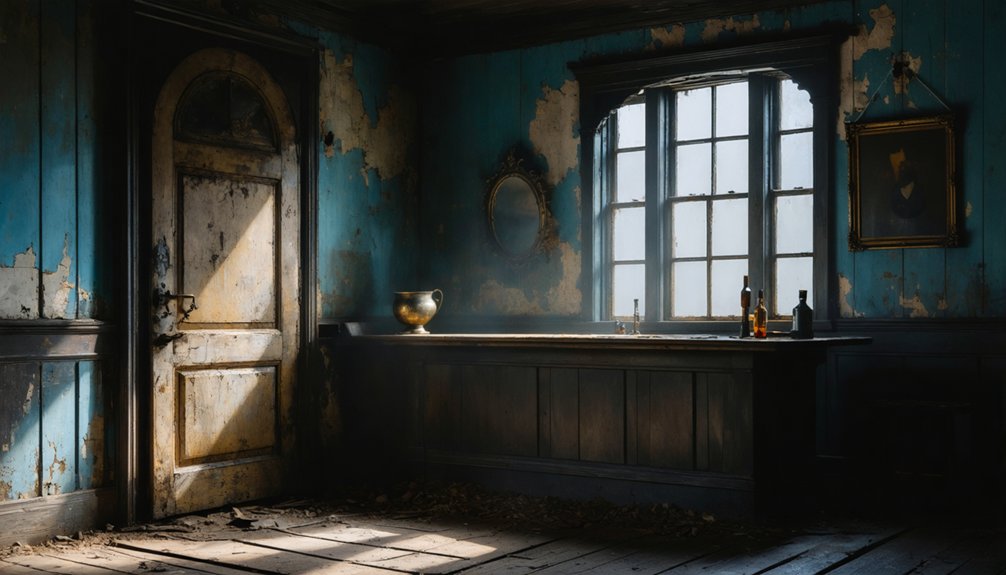You’ll find Oregon’s ghost towns most rewarding when you map a circuit through Eastern Oregon, join guided tours, photograph at golden hours, and pack proper safety gear. Research mining history before visiting sites like Golden or Greenhorn, explore back roads, document oral histories, and practice responsible exploration ethics. Combine your ghost town adventures with Oregon Trail historic sites for a deeper connection to the past. The stories behind these weathered buildings await your discovery.
Key Takeaways
- Engage local guides and tours for exclusive access to restricted areas and untold historical stories.
- Prepare proper safety gear including sturdy boots, headlamps, and first aid kits before entering abandoned structures.
- Document sites during golden hour with HDR photography while respecting no-artifact-removal ethical guidelines.
- Combine ghost town exploration with Oregon Trail history by following scenic byways and visiting interpretive centers.
- Attend seasonal festivals like Buncom Day to experience ghost town culture alongside local community members.
Map Your Ghost Town Circuit Through Eastern Oregon
Where should you begin your journey into Oregon’s forgotten past? Start by plotting a course along the state highways that thread through the eastern region.
SH 207, 26, and 395 serve as your main arteries to ghost town exploration, connecting hubs like Heppner and Ruggs to abandoned settlements like Hardman and Shaniko.
Your mapping strategies should include both digital and analog tools—GPS coordinates for precision, but don’t forget paper maps for when cell service disappears in these remote pockets of history.
The most efficient ghost town itineraries link sites with practical considerations: fuel availability, road conditions, and seasonal access. Oregon boasts the most ghost towns in the United States, giving travelers numerous options to customize their historical adventure.
Plan your ghost town adventure like a seasoned explorer—balance historical discovery with practical travel logistics.
These abandoned communities have been classified into three distinct categories based on their current state and remaining structures: True, Partial, and Tourist ghost towns.
Before heading out, check TripCheck.com for closures and weather advisories.
Join Guided Historical Tours of Preserved Sites
You’ll gain invaluable insights from experienced local guides who know the hidden stories behind Oregon’s ghost towns.
These knowledgeable historians can take you beyond the visible ruins to explore otherwise inaccessible tunnels, basements, and preserved structures.
With guides from organizations like Pendleton Underground Tours or Northwest Ghost Tours, you’re getting behind-the-scenes access that reveals the authentic daily life of these once-thriving communities. Tours last approximately 90 minutes and proceed in all weather conditions, so be prepared with appropriate gear. These tours consistently receive high customer satisfaction as most have ratings above 4.5 stars.
Experienced Local Guides
Three distinct advantages emerge when exploring Oregon’s ghost towns with experienced local guides. These storytellers breathe life into weathered buildings and forgotten streets through their deep knowledge of town histories, often seasoned with compelling local lore that you won’t find in guidebooks. In Jacksonville, Oregon, visitors can experience this firsthand through haunted evening tours that share stories of local pioneers and spirits throughout the summer and fall months.
You’ll benefit from authentic historical interpretations as guides connect you to the economic booms, pioneer struggles, and cultural shifts that shaped these abandoned communities. Many of these settlements once attracted hundreds of families from around the world seeking opportunity in Oregon’s resource-rich landscapes. They expertly blend factual accounts with folklore, transforming forgotten places into engaging narratives.
Most importantly, local guides provide responsible access to sites that might otherwise remain off-limits or dangerous to explore alone. They’ll navigate you through preserved structures while emphasizing respectful interaction with these fragile historical treasures—allowing you to experience Oregon’s past without compromising its preservation for future adventurers.
Behind-the-Scenes Access
Gaining exclusive behind-the-scenes access transforms ordinary ghost town visits into extraordinary historical journeys across Oregon’s abandoned landscapes. Through guided tours, you’ll experience restricted areas where archival access reveals untold stories of boom-and-bust cycles that shaped these forgotten communities.
- Explore privately-owned ghost towns typically closed to the public
- Examine original artifacts and historical documents not displayed in public collections
- Participate in historical storytelling sessions featuring rare photographs and personal accounts
- Enter carefully preserved structures with expert guidance on their architectural significance
Unlike self-guided explorations, these curated experiences offer intimate glimpses into pioneer life through professionally preserved records and structures. Many tours highlight towns like Danner which was originally promoted as Ruby Town but never flourished due to the harsh climate conditions.
You’ll sign liability waivers that grant freedom to venture where independent travelers cannot, while expert guides guarantee both your safety and the protection of these fragile historical treasures.
Photograph Abandoned Architecture at Sunrise and Sunset
You’ll discover Oregon’s ghost towns transform into photographers’ paradises during the golden hours, when sunrise and sunset bathe weathered structures in warm, dramatic light.
Position yourself to capture long shadows that emphasize architectural details while using the low-angle sunlight to highlight textures of rusted metal and weathered wood.
Your images preserve these vanishing historical treasures through thoughtful composition techniques that incorporate natural elements and leading lines along abandoned main streets. With over 80 ghost towns listed on the national register, Oregon offers countless opportunities to document these historical sites before they disappear completely. Exploring towns like Shaniko or Golden provides excellent photographic subjects just a couple hours from Portland.
Dramatic Lighting Techniques
The dramatic interplay of light and shadow during sunrise and sunset transforms Oregon’s ghost towns into photographers’ paradises, creating once-in-a-day opportunities to capture these abandoned settlements in their most evocative state.
The golden and blue hours offer perfect conditions for atmospheric compositions that reveal textures of weathered wood, rusted metal, and crumbling stone. A 17-50mm f/2.8 lens provides ideal versatility for capturing both expansive architectural scenes and intimate details in these variable lighting conditions.
- Position yourself low to the ground to maximize dramatic shadows cast by deteriorating structures
- Utilize spot metering on highlighted architectural features to prevent overexposure
- Stabilize your camera with a tripod for sharp long exposures in fading light
- Supplement natural light with subtle artificial illumination to reveal hidden interior details
You’ll discover each ghost town has its own unique character that emerges when bathed in directional light—stories of Oregon’s past waiting to be captured through your lens.
Preservation Through Pictures
Photography serves as a powerful tool for preserving Oregon’s vanishing architectural heritage, especially when captured during the ethereal light of sunrise and sunset.
You’ll find these golden hours offer the perfect balance of warm, directional light that enhances weathered textures and architectural lines without harsh shadows.
When shooting, respect private property boundaries and follow Leave No Trace principles—remember these structures hold cultural significance beyond their photogenic qualities.
Use a tripod during these low-light periods and try HDR techniques to balance exposure between bright skies and shadowed buildings.
In post-processing, photo editing shouldn’t overpower the authentic character of these historic sites.
Instead, subtle adjustments can emphasize the craftsmanship while documenting architectural details that mightn’t survive another decade.
Your images become essential records of Oregon’s frontier past.
Pack Essential Gear for Remote Ghost Town Expeditions
Preparing properly for ghost town expeditions can mean the difference between an enriching historical adventure and a potentially dangerous situation. Your gear selection should prioritize safety and versatility in Oregon’s unpredictable remote environments.
Invest in sturdy hiking boots that protect against debris and uneven terrain, while layering clothing allows adaptation to shifting weather conditions.
- Carry high-lumen flashlights and headlamps with backup batteries for traversing dark structures safely.
- Pack offline maps alongside digital navigation tools to guarantee you’re never truly lost.
- Bring protective equipment including dust masks and cut-resistant gloves to handle hazardous materials.
- Stock a thorough first aid kit, emergency whistle, and plenty of water for unexpected situations.
Always inform someone of your route before venturing into these forgotten pieces of history.
Research Mining History Before Visiting Golden and Greenhorn
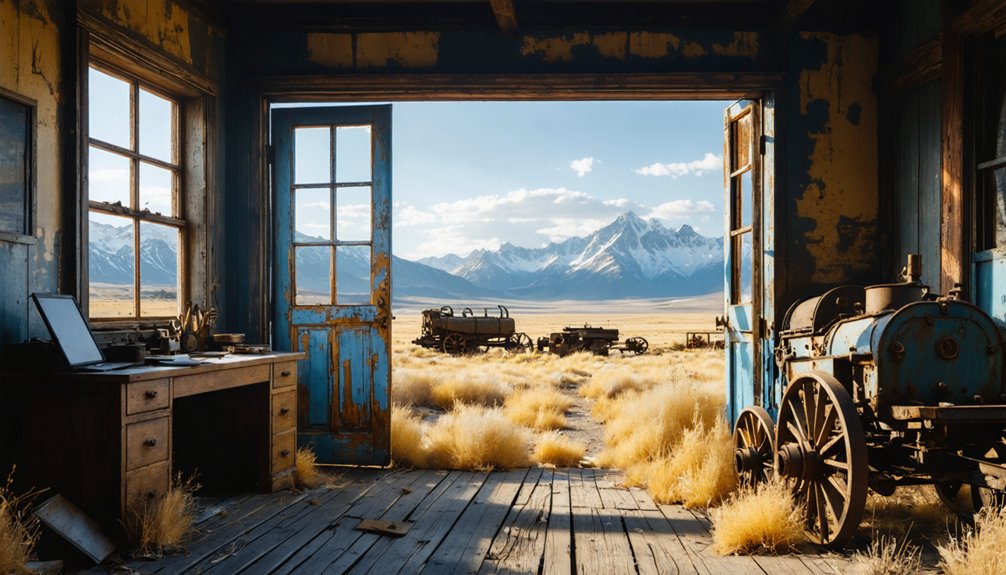
Before exploring Golden and Greenhorn, you’ll want to understand the timeline from the 1850s placer mining to the 1890s hydraulic operations that shaped these towns.
Look for remnants of the Ruble Elevator and the two-and-a-half-mile pipeline that powered Golden’s $1.5 million gold recovery.
You can also spot traces of Chinese miners’ contributions through their extensive ditch systems, which remind us of laborers who earned just ten cents daily while creating the infrastructure that made these boomtowns possible.
Mining Equipment Artifacts
A treasure trove of mining equipment awaits curious explorers at Oregon’s ghost towns, but researching these artifacts before your visit will dramatically enhance your experience at Golden and Greenhorn.
You’ll recognize the historical equipment that transformed these once-bustling communities, from simple gold pans to massive stamp mills.
When exploring these sites, watch for:
- Industrial remnants – Look for foundations of 20-stamp mills, flotation machinery, and steeply-pitched roofs designed for heavy snowfall.
- Repurposed materials – Notice tin cans modified as structural reinforcements.
- Surface artifacts – Square nails, glass fragments, and bullet casings reveal daily life.
- Landscape alterations – Identify prospect pits, ditches, and tailings that show how hydraulic mining reshaped entire hillsides.
Mining artifacts tell stories of innovation, desperation, and the freedom pioneers sought in Oregon’s mountains.
Chinese Miner Contributions
While mining equipment tells the technical story of Oregon’s ghost towns, the human narrative remains incomplete without understanding the Chinese miners who transformed the region.
When visiting sites like Golden or Jacksonville, you’ll walk ground where Chinese laborers comprised nearly half of Southwestern Oregon’s mining population by the 1860s.
These resourceful workers introduced innovative Chinese mining techniques, including hydraulic methods requiring extensive ditch networks—many still visible today. They masterfully reworked abandoned claims, extracting gold others missed through efficient, labor-intensive approaches.
Despite facing discrimination and exclusion laws, their economic contributions were substantial.
Before exploring Applegate Valley, research Gin Lin, a successful mining boss who purchased land when few Chinese could.
The Oregon Chinese Diaspora Project continues uncovering artifacts that tell the story of these overlooked pioneers.
Gold Rush Timeline
Oregon’s gold rush history began much earlier than many visitors realize, with the first glimmers of gold discovered in 1850 at Big Bar near Rock Point on the Rogue River.
As you explore these abandoned towns, understanding the timeline helps bring their stories to life.
When researching mining history before your adventure, focus on these key periods:
- 1851: First major strike on Josephine Creek sparked the southern Oregon rush
- 1851-1852: Rich Gulch discovery led to Jacksonville’s founding
- 1850s: Peak boom years for towns like Golden and Waldo
- 1860s: Shift from placer to hydraulic mining techniques
Gold discovery locations typically featured specific geography—steep canyons with nearby creeks—perfect for early placer mining.
Attend Seasonal Festivals Like Buncom Day

Seasonal festivals breathe life into Oregon’s forgotten settlements, offering you a unique opportunity to experience these historic sites at their most vibrant.
Buncom Day, held annually on May’s last Saturday, transforms this well-preserved ghost town into a celebration of Wild West heritage.
Step back in time as Buncom’s dusty streets come alive with Wild West revelry every May.
Immerse yourself in Buncom history through interactive experiences while supporting preservation of the town’s historic structures. Join the no-registration-required parade, enjoy local musicians, browse regional goods at country stores, or bring your kids to the petting zoo.
Just 20 miles southwest of Medford, this festival combines education about Oregon’s mining era with authentic entertainment.
While exploring, remember to respect these fragile historical sites—take only photographs, leave only footprints as you connect with these remarkable remnants of frontier life.
Explore Ghost Towns Along Oregon’s Back Roads
Venturing off the beaten path onto Oregon’s network of back roads reveals a treasure trove of forgotten settlements waiting to be discovered.
Routes 78, 20, and 395 connect fascinating ghost towns like Shaniko, Sumpter, and Golden, each telling unique stories of Oregon’s pioneering past.
- Pack detailed maps and emergency supplies—cell service disappears quickly on these remote gravel roads.
- Time your ghost town photography for golden hour when weathered buildings glow with character.
- Follow historical preservation ethics by never removing artifacts, however tempting they might be.
- Check TripCheck.com before journeying to remote locations like Danner or Hardman, especially during winter months.
Travel these historic stagecoach routes and witness the Pillars of Rome, abandoned post offices, and century-old cemeteries that whisper tales of boom-and-bust cycles.
Document Oral Histories From Remaining Residents

Behind each weathered façade and creaking floorboard of Oregon’s ghost towns lives a story waiting to be preserved—told through the voices of those who’ve witnessed their community’s transformation firsthand.
Seek out remaining residents in places like Shaniko or Granite by connecting with local preservation societies and attending community events.
The true gatekeepers of ghost town history await your meeting—find them through preservation societies and local gatherings.
When you’re ready to capture these precious oral traditions, bring quality recording equipment and thoughtfully prepared questions about boom-and-bust cycles, community life, and historic landmarks.
Always obtain informed consent before recording, respecting privacy while preserving these essential community narratives.
Partner with local museums or historical societies to guarantee these stories endure for generations.
The most profound ghost town exploration isn’t just about abandoned buildings—it’s about connecting with the human experience that shaped these fascinating places.
Practice Responsible Urban Exploration Ethics
While exploring Oregon’s historic ghost towns offers a thrilling glimpse into the past, responsible urban exploration demands more than just curiosity—it requires a steadfast commitment to ethical practices.
When you venture into these time capsules, your actions directly impact their preservation for future generations.
- Follow the cardinal rule of urban ethics: “Take only photos, leave only footprints”—never remove artifacts or disturb structures.
- Research ownership and access rights beforehand to avoid trespassing on protected lands.
- Use appropriate safety gear and inspect buildings from a distance before entering any potentially unstable structures.
- Engage respectfully with local communities and Indigenous groups whose histories intertwine with these abandoned places.
Your exploration etiquette determines whether these fragile windows into Oregon’s past survive or disappear forever.
Combine Ghost Town Visits With Oregon Trail History
To truly immerse yourself in Oregon’s rich pioneer heritage, you’ll discover unexpected depth when you combine ghost town exploration with Oregon Trail history. Towns like Baker City and Canyon City weren’t just settlements—they were essential supply points for weary emigrants pushing westward.
Follow the Oregon Trail Scenic Byway to experience this intertwined cultural heritage. Stop at historical markers and interpretive signs connecting these stories, or visit the National Historic Oregon Trail Interpretive Center near Baker City.
Travel the Oregon Trail Scenic Byway, where historical markers and the interpretive center near Baker City reveal pioneer stories frozen in time.
Here, exhibits reveal how gold discoveries and subsequent mining booms transformed trail routes into thriving (then abandoned) communities.
For deeper insights, check local archives in Baker, Grant, and Wasco counties, where maps detail how these ghost towns sprang up along trail corridors before gradually fading into Oregon’s fascinating historical landscape.
Frequently Asked Questions
Are Any Oregon Ghost Towns Rumored to Be Haunted?
You’ll encounter a million haunted legends in Oregon’s ghost towns! Golden, Buncom, and Shaniko offer spine-tingling ghostly sightings, while the eerie Witch’s Castle and Wolf Creek Inn amplify your supernatural adventure.
Can I Camp Overnight in or Near Ghost Towns?
Yes, you can camp near ghost towns following dispersed camping regulations on BLM or state forest land. Check fire restrictions and prioritize ghost town safety by avoiding unstable structures.
What Should I Do if I Find Artifacts?
While your fingers itch to collect, artifact preservation demands restraint. Don’t touch or remove findings—photograph them, note their location, and report to authorities. Local regulations protect these irreplaceable windows to our past.
Which Ghost Towns Are Accessible During Winter Months?
You’ll find Granite, Shaniko, Golden, Chitwood, and Cornucopia accessible during winter months. Check winter accessibility before traveling as ghost town conditions vary based on elevation and road maintenance status.
Do Any Ghost Towns Host Paranormal Investigation Tours?
Shadows of the past beckon you through formal ghost tours in Portland, Oregon City, and Astoria, where paranormal events weave history with mystery. You’ll find EMF detectors and haunted tunnels await your free-spirited exploration.
References
- https://thatoregonlife.com/2016/04/road-trip-ghost-towns-eastern-oregon/
- https://traveloregon.com/things-to-do/culture-history/ghost-towns/secrets-oregons-ghost-towns/
- https://www.visitoregon.com/oregon-ghost-towns/
- https://www.youtube.com/watch?v=dBCOeX8_ItY
- https://en.wikipedia.org/wiki/List_of_ghost_towns_in_Oregon
- https://www.pdxmonthly.com/travel-and-outdoors/oregon-ghost-towns
- https://now.acs.org/public/detail/Documents/oregon ghost towns.pdf
- https://traveloregon.com/things-to-do/culture-history/ghost-towns/
- https://stage-sos.oregon.gov/archives/exhibits/ghost/Pages/about-hunting.aspx
- http://www.photographoregon.com/ghost-towns.html
